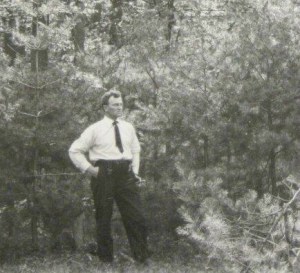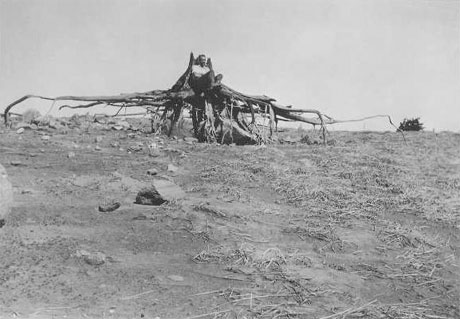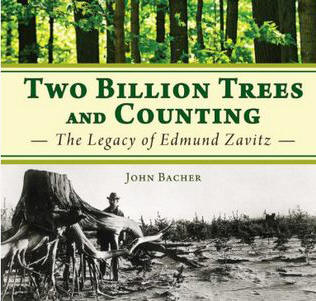
Ganaraska Forest
-
Conservation History -
homepage
Ganaraska History
V.B. Blake
Pioneer Historian
E. J.
Zavitz
Chief of Reforestation
A.H.
Richardson
Forester
Dr. R.C.
Wallace
"Wallace of Queen's"
G.M. Wrong
History Prof./Author
Lois James
Champion
of the Rouge
links
email
“The Zavitz story provides inspiration for a new generation of tree planters in both urban and rural spaces. Efforts underway to double the tree canopy in Toronto, the GTA and Ottawa seem altogether minor in comparison to the 2 billion trees planted across the province in his time.”
Edmund Zavitz planted the idea for 2 billion treesMark Cullen: Toronto Star, November 2, 2012

Early Photo - Edmund J. Zavitz
From his youth, E.J. Zavitz (1875-1968) was strongly influenced by his early experiences in the Ganaraska region spending time at both his grandfather's and uncle's farms.
|
"As a young boy Zavitz spent time with his
grandfather and uncle on their farms
on the headwaters of the Ganaraska River. From his
family he first learned the value of
trees and of the devastating effects
of early logging and farming
practices that stripped the land of
protective forest cover and exposed
the fragile soil to the attacks of
wind, flood and fire."
Ralph McKim, |
A keen interest in conservation and reforestation, E. J. Zavitz graduated from the University of Michigan in 1905 with the degree of Master of Science in Forestry. He was then appointed lecturer at the Ontario Agricultural College in Guelph. He also lectured at the University of Toronto.
Regarded as the Father of Reforestation, Zavitz developed a reforestation program for eroded lands in Southern Ontario.
Zavitz was also the author of many landmark reports and handbooks on reforestation.
|
“Between 1790 and the early 1900s,
Ontario was denuded of all of its
existing forests through the efforts of
lumbermen and farmers. The results were
devastating. Wildlife disappeared,
streams and rivers dried up, and sand
and top soil blew away. In 1904, an ambitious professor from the University of Toronto in forestry proposed to province that it would be a good idea to establish an aggressive replanting program in the marginally productive areas of the province. In fact, he wanted to more than triple the existing tree cover in Southern Ontario. It was an audacious idea and he had a lot of nerve. His name was Edmund Zavitz and his story is worth repeating…”
Edmund Zavitz planted the idea for 2
billion trees
|

Edmund Zavitz amidst the desolation he
worked
to redeem. Photograph: Edward Borczon
In 1908, Zavitz expressed the first reforestation and conservation vision for the Ganaraska and Oak Ridges Moraine areas. According to Zavitz in his Report on the Reforestation of Wastelands in Southern Ontario:
|
"Extending though Northumberland and Durham Counties is a sand formation locally known as the "Oak Ridge" or "Pine Ridge"... It is safe to say that seventy-five percent is wholly unfit for successful farming... These areas should be preserved for the people of Ontario as recreation grounds for all time to come... The policy of putting these lands under forest management has many arguments in its favour... It will pay as a financial investment; assist in insuring a wood supply; protect the headwaters of streams; provide breeding ground for wild game; provide object lessons in forestry; and prevent citizens from developing under conditions which can end only in failure. " Report
on the Reforestation of Waste Lands in Ontario Department of Agriculture, Toronto |
From 1912 to 1949, Zavitz had great influence over the governments of the day.
“The vision that Edmund Zavitz was to
develop and (to a large extent) realize
is difficult to imagine today. So much
of what we take for granted was part of
his vision. He provided great influence
over the governments between 1912 and
1949. He provided scientifically-based
arguments that successive governments
understood and, for the most part,
supported, crossing political lines
between the early Farmers Union Party,
the Progressive Conservatives and the
Liberals."
Edmund Zavitz planted the idea for 2
billion trees
|
In 1912, E. J. Zavitz became the first provincial forester at the Ontario Ministry of Lands, Forests and Mines.
In 1924, E. J. Zavitz became Deputy Minister of Forestry.
In 1935, Zavitz was appointed Chief of Reforestation. To fellow foresters, he was simply known as "E.J. - the foster father of a billion trees".
|
"When Zavitz launched his ambitious plan
as the newly minted “Chief Forester” to
replant up to 30 per cent of the land
mass in Southern Ontario, he produced
black and white slides from his
extensive collection and used them to
illustrate his point. He travelled
around the province on a public speaking
circuit, preaching the merits of
reforestation to anyone who would
listen. While many municipal officials did not embrace his message in the beginning, he did succeed in swaying the opinion of many farmers, who considered themselves stewards of the land and understood the thesis that much of the now-barren real estate in the country was never going to be productive for agriculture."
Edmund Zavitz planted the idea for 2
billion trees
|
Following his graduation in 1920, Dr. Zavitz hired A. H. Richardson as a forest engineer. Richardson became his long-time assistant in the Forestry Branch of the Department of Lands and Forests. A.H. Richardson was appointed as full-time Chairman by the Ontario Government in 1942 to organize the Ganaraska study.
Ganaraska Forest was established on the Oak Ridges Moraine in 1947 -- the largest conservation project on the moraine.
Today, Ganaraska Forest is part of the world's largest greenbelt (Ontario's Greenbelt) - the large areas of reforested land attributed to the vision of Zavitz over a century ago.
“We have proof that the Zavitz strategy works. Thanks to aggressive tree planting last century, we are seeing the arrival of rare bird species like the red-shouldered hawk and red-headed woodpecker; and there are streams populated with brook trout where there were none a century ago. The flooding of our towns and cities came to an all but complete stop due to the Zavitz tree-planting plan. Forest fires were reduced dramatically through proper forest management, and streams and rivers returned to their once gloriously productive state. Once trees were re-established in the head waters of the Don, Credit, Ganaraska rivers, and many other natural waterways, life became normal once again.”
Edmund Zavitz planted the idea for 2 billion trees
Mark Cullen: Toronto Star, November 2, 2012
|
“To ignore the Zavitz story is to deny our forbearers much credit for creating the natural beauty, safety and productivity that we enjoy in our provincial parks, conservation areas, and wide tracts of private land that were forested with his leadership.”
Edmund Zavitz planted the idea for 2 billion
trees
|
Highly recommended book...
|
Two Billion Trees and Counting - The Legacy of Edmund Zavitz - by John Bacher
Edmund Zavitz (1875–1968) rescued Ontario from the ravages of increasingly more powerful floods, erosion, and deadly fires. Wastelands were talking over many hectares of once-flourishing farmlands and towns. Sites like the Oak Ridges Moraine were well on their way to becoming a dust bowl and all because of extensive deforestation. Zavitz held the positions of chief forester of Ontario, deputy minister of forests, and director of reforestation. His first pilot reforestation project was in 1905, and since then Zavitz has educated the public and politicians about the need to protect Ontario forests. By the mid-1940s, conservation authorities, provincial nurseries, forestry stations, and bylaws protecting trees were in place. Land was being restored. Just a month before his death, the one billionth tree was planted by Premier John Robarts. Some two billion more would follow…” Amazon |
c2014
M. Martin
